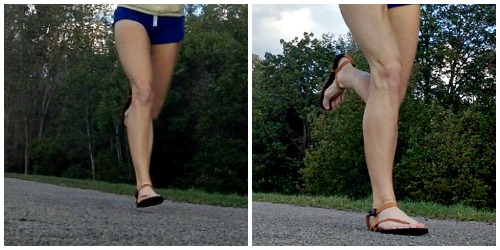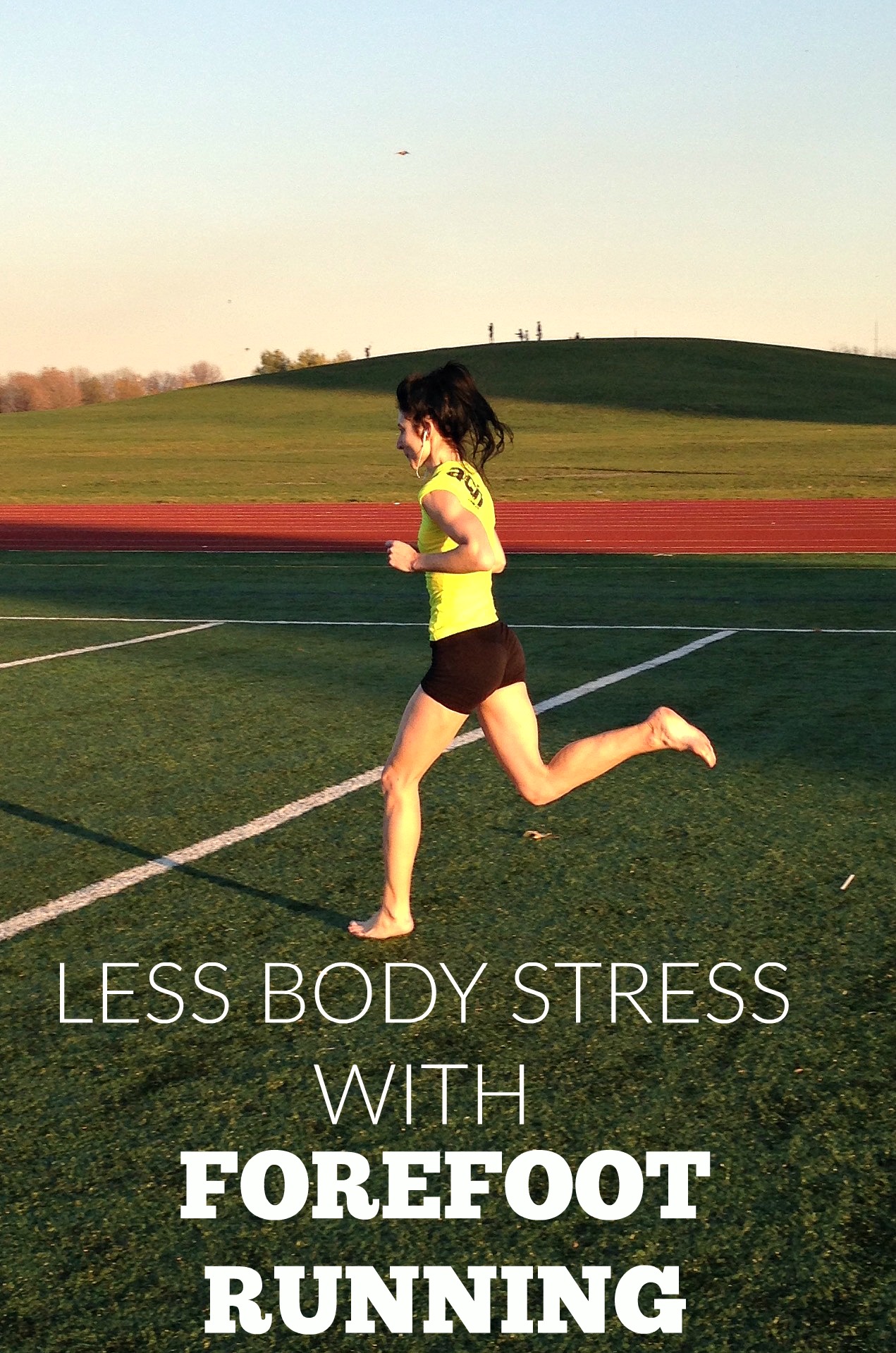There is something about forefoot running that results in less body stress and that something, in part is knee flexion. Unlike heel strike running, forefoot running reduces muscle loading because it typically involves greater knee flexion at touchdown.
Less Body Stress with Forefoot Running
Landing on the forefoot with greater knee flexion reduces vertical impact forces [1]. This suggests that forefoot running is a positive intervention on running biomechanics than heel striking –a running style that produces higher vertical impact forces.

- In forefooot running, after forefoot contact, the heel is brought down to the ground to initiate stance where the downward movement of the thigh and upper body forces the knee into flexion [1]. This is what softens the blow at contact and protects the leg.
Why Heel Striking is Worse
The reverse occurs when heel striking (increased knee extension and decreased knee flexion time at touchdown) which results in less shock absorption and an affinity for greater loading and tension on the muscles and tendons.
Another factor of heel striking that adds to vertical impact forces is high vertical oscillation. Heel strike runners tend to run with a higher ‘bounce’, or higher jumping height than forefoot runners. Previous studies have shown that increased knee extension coupled with jumping height at touchdown [2], resulted in higher vertical impact forces, creating challenging circumstances for injury prevention during heel striking.
The Take Home Message
A low vertical impact force is one reason many runners have been able to adjust smoothly to forefoot running because the muscles and joints are less sensitive to injury.
Since footwear influences foot strike competence, you need to understand that certain footwear causes a runner to heel strike, whereas other forms of footwear encourages a runner to avoid heel strike by landing on the forefoot. Click here to read more about the proper footwear for forefoot running.
More from Run Forefoot:
Why Older Runners Need to Wear Minimalist Shoes – Find out how minimalist running shoes prevent age-related biomechanical impairments in older runners.
The Cause of ITBS – Understand how running shoes that are stiff and inflexible increases a runner’s risk of ITBS.
Expensive Shoes Doesn’t Mean More Protection – A study found that cheaper running shoes were linked to less injury rates than pricier ones.
Protecting Your Joints – Discover how the best joint protection technique for running is to avoid heel strike.
Born to Run…Forefoot? Here I talk about why humans are anatomically suited for forefoot running, and not heel strike running.
Are Heel Strikers Slower? Here I uncover the 2 main reasons that may slow a heel striker down.
The Neuroscience of Running….Barefoot – An overview of how barefoot running boosts motor coordination patterns in the brain, helping you run with better mechanics.
Shoes for Forefoot Strikers – Read about the barefoot-inspired running shoes that help avoid heel strike.
References:
[1]. Dufek J and Bates BT. The evaluation and prediction of impact forces during landing. Med Sci Sports Exerc, 1990; 22(2):370-377.
[2]. Stacoff et al. Impact in landing after a volleyball block. In: Biomechanics XI, G. de Groot, A. Hollander, P. Huijing, and G van Ingen Schenau (Eds). Amsterdam: Free University Press, 1988, pp. 694-700.
Bretta Riches
BSc Neurobiology; MSc Biomechanics candidate, ultra minimalist runner & founder of RunForefoot. I was a heel striker, always injured. I was inspired by the great Tirunesh Dibaba to try forefoot running. Now, I'm injury free. This is why I launched Run Forefoot, to advocate the health & performance benefits of forefoot running and to raise awareness on the dangers of heel striking, because the world needs to know.
Latest posts by Bretta Riches (see all)
- Heel Lifts Increase Injury in Runners - 16/04/2024
- Are Minimalist Shoes Good for Seniors? YES! - 14/04/2024
- BIG Deals On Running Gear And More! - 09/04/2024


Leave a Reply